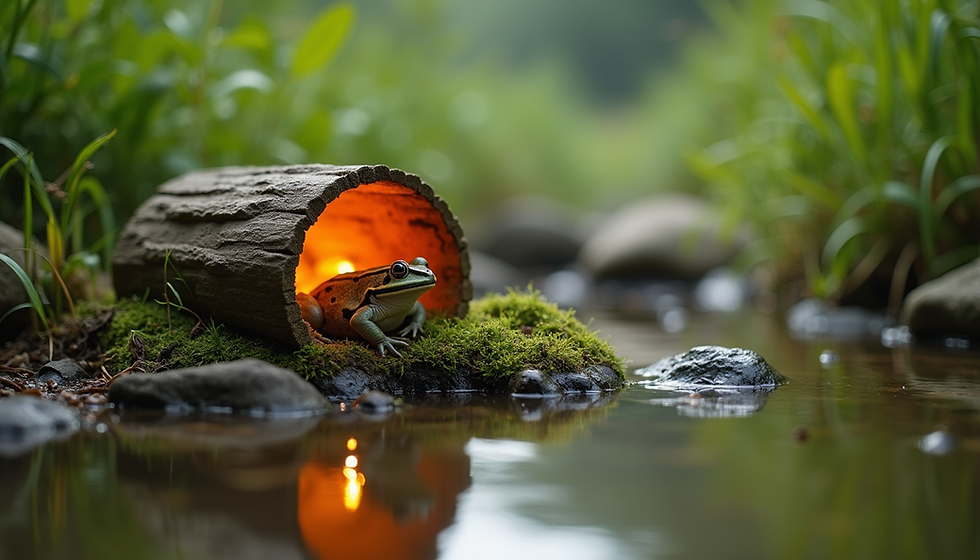Creative DIY Ideas for Building Custom Reptile Enclosures
- Joel Scoby

- 14 hours ago
- 3 min read
Creating a comfortable and stimulating home for your reptile can be a rewarding project. Building your own reptile enclosure allows you to customize the space to fit your pet’s specific needs, personality, and your style. This guide offers practical ideas and tips for crafting custom reptile habitats that are both functional and visually appealing.

Choosing the Right Materials
Selecting materials is the first step in building a reptile enclosure. The choice depends on the type of reptile, its size, and environmental needs.
Glass tanks are popular for many reptiles because they provide clear visibility and retain humidity well. They work best for species that require high humidity, like geckos or amphibians.
PVC or plastic enclosures are lightweight and easy to clean. They offer good insulation and are suitable for reptiles that need stable temperatures.
Wooden enclosures provide excellent insulation and can be customized with ventilation and secure doors. Use untreated, reptile-safe wood to avoid harmful chemicals.
Screen cages are ideal for reptiles that need excellent airflow, such as bearded dragons or anoles. Ensure the screen is sturdy and escape-proof.
When building, consider using non-toxic sealants and paints to protect your pet’s health.
Designing for Your Reptile’s Needs
Each reptile species has unique habitat requirements. Tailoring the enclosure design to these needs ensures your pet thrives.
Temperature gradients: Create warm and cool zones using heat lamps or pads. Position basking spots where your reptile can regulate its body temperature.
Humidity control: Incorporate misting systems or water features for species that need higher humidity. Use substrates that retain moisture without molding.
Lighting: UVB lighting is essential for many reptiles to synthesize vitamin D3. Design the enclosure to accommodate proper lighting fixtures safely.
Space and enrichment: Provide enough room for movement and climbing. Add branches, rocks, hides, and plants to mimic natural environments and reduce stress.
Building Tips for Custom Enclosures
Here are some practical tips to help you build a sturdy and safe reptile enclosure:
Measure carefully before cutting materials to ensure a snug fit.
Use weather stripping or silicone sealant to close gaps and prevent escapes.
Install secure locks on doors or lids to keep your reptile safe.
Add ventilation panels to maintain airflow without compromising temperature or humidity.
Consider modular designs that allow you to expand or modify the enclosure as your reptile grows.

Creative Ideas to Personalize Your Enclosure
Customizing your reptile’s home can make it more enjoyable for both you and your pet.
Themed habitats: Design enclosures inspired by deserts, rainforests, or tropical islands using appropriate decor and plants.
Naturalistic backgrounds: Use cork bark, foam, or textured panels painted to resemble rocks or tree bark.
Built-in feeding stations: Create small compartments or shelves for food and water dishes to keep the enclosure tidy.
Hidden compartments: Incorporate secret spaces for heating elements or storage of supplies.
Lighting effects: Use LED strips or colored bulbs to simulate dawn, dusk, or moonlight cycles.
Example Project: A Wooden Desert Terrarium
For a bearded dragon, a wooden terrarium with a desert theme can be both practical and attractive.
Use untreated plywood for the frame and seal it with reptile-safe varnish.
Install a glass front door with secure locks for easy access.
Add a heat lamp on one side to create a basking area.
Line the bottom with sand-like substrate and place flat rocks for climbing.
Attach a cork bark background painted in warm tones.
Include a shallow water dish and a hide made from a hollow log.
This setup provides warmth, space, and enrichment while blending naturally into home decor.
Maintaining Your DIY Enclosure
Once your enclosure is built, regular maintenance keeps it safe and comfortable.
Clean the enclosure weekly, removing waste and uneaten food.
Check heating and lighting equipment for proper function.
Monitor temperature and humidity levels daily with reliable gauges.
Replace substrates as needed to prevent mold and bacteria.
Inspect seals and locks to ensure no gaps or weaknesses develop.



Comments